|
|
 |
|
Cyclopoida ( Order ) |
|
|
|
Corycaeidae ( Family ) |
|
|
|
Corycaeus ( Genus ) |
|
|
|
Onychocorycaeus ( Sub-Genus ) |
|
|
| |
Corycaeus (Onychocorycaeus) latus Dana, 1849 (F,M) | |
| | | | | | | Syn.: | Corycaeus laticeps Dana,1849; 1852;
Corycaüs ovalis : Giesbrecht, 1892 (Pl.49, fig.20, Pl.51, ? figs.1,3 : F; fig.2: M);
no C. latus : Mori, 1937 (1964) (p.136) ;
Onychocorycaeus latus : Dessier, 1983 (p.89, Tableau 1, Rem., %); Boxshall & Halsey, 2004 (p.494); Valdés & al., 2007 (p.104: tab.1); McKinnon & al., 2008 (p.844: Tab.1); Vives & Shmeleva, 2010 (p.237, figs.F,M, Rem.); Belmonte & al., 2013 (p.222, Table 2, abundance vs stations); Marques-Rojas & Zoppi de Roa, 2017 (p.495, Table 1); El Arraj & al., 2017 (p.272, table 2 (as Onchocorycaeus), spatial distribution); | | | | Ref.: | | | F. Dahl, 1894 (p.72); M. Dahl, 1912 (p.93, figs.F,M); Farran, 1929 (p.211, 296); Rose, 1929 (p.70); 1933 a (p.331, figs.F,M); Klevenhusen, 1933 a (p.88, chart 40); Dakin & Colefax, 1940 (p.113, figs.M); Tanaka, 1957 (p.95, Rem.); Motoda, 1963 (p.240, figs.M); Owre & Foyo, 1967 (p.123, figs.F,M); Vilela, 1968 (p.39, figs.F,M); Marques, 1968 a (p.397); 1973 (p.250, fig.M); Razouls, 1972 (p.96, Annexe: p.133, figs.M); 1974 c (1975) (p.90, figs.M); Björnberg & al., 1981 (p.676, fig.M); M. Lefèvre, 1986 (p.33); Lakkis & Zeidane, 1987 (p.20, figs.M, Rem.); Boxshall, 1998 (p.224); Bradford-Grieve & al., 1999 (p.888, 975, figs.F,M); | 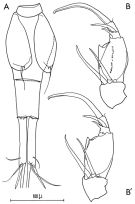 issued from : C. Razouls in Vie Milieu, 1974, 24 (1.A). [p.107, Fig.9]. Male (from W Medit.: Banyuls, France): A, urosome (ventral); B-B', A2.
|
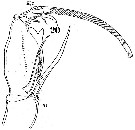 Issued from : W. Giesbrecht in Systematik und Faunistik der Pelagischen Copepoden des Golfes von Neapel und der angrenzenden Meeres-Abschnitte. – Fauna Flora Golf. Neapel, 1892. Atlas von 54 Tafeln. [Taf.49, Fig.20]. As Corycäus ovalis. Male : 20, A2.
|
 Issued from : W. Giesbrecht in Systematik und Faunistik der Pelagischen Copepoden des Golfes von Neapel und der angrenzenden Meeres-Abschnitte. – Fauna Flora Golf. Neapel, 1892. Atlas von 54 Tafeln. [Taf.51, Fig.2]. As Corycäus ovalis. Male: 2, urosome (ventral).
|
 Issued from : W. Giesbrecht in Systematik und Faunistik der Pelagischen Copepoden des Golfes von Neapel und der angrenzenden Meeres-Abschnitte. – Fauna Flora Golf. Neapel, 1892. Atlas von 54 Tafeln. [Taf.51, Fig.1]. As Corycäus ovalis. Female: 1, habitus (dorsal). Ce = cephalosome; Th = metasomal segment; Ab = urosomal segment.
|
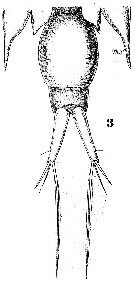 Issued from : W. Giesbrecht in Systematik und Faunistik der Pelagischen Copepoden des Golfes von Neapel und der angrenzenden Meeres-Abschnitte. – Fauna Flora Golf. Neapel, 1892. Atlas von 54 Tafeln. [Taf.51, Fig.3]. As Corycäus ovalis. Female: 3, urosome (dorsal).
|
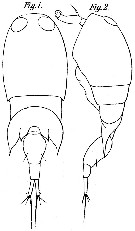 issued from : M. Dahl in Ergebnisse der Plankton-Expedition der Humboldt-Stiftung. Bd II, G. f1. I. Die Corycaeinen 1912. [Taf.XIII, Figs.1, 2]. Female: 1, habitus (dorsal); 2, idem (lateral left side).
|
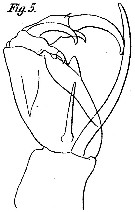 issued from : M. Dahl in Ergebnisse der Plankton-Expedition der Humboldt-Stiftung. Bd II, G. f1. I. Die Corycaeinen 1912. [Taf.XIII, Fig.5]. Female: 5, A2.
|
 issued from : M. Dahl in Ergebnisse der Plankton-Expedition der Humboldt-Stiftung. Bd II, G. f1. I. Die Corycaeinen 1912. [Taf.XIII, Figs.7, 8]. Female: 7, endopod of P2; 8, P4.
|
 issued from : M. Dahl in Ergebnisse der Plankton-Expedition der Humboldt-Stiftung. Bd II, G. f1. I. Die Corycaeinen 1912. [Taf.XIII, Figs.3, 4]. Male: 3, habitus (dorsal); 4, idem (lateral left side).
|
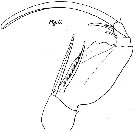 issued from : M. Dahl in Ergebnisse der Plankton-Expedition der Humboldt-Stiftung. Bd II, G. f1. I. Die Corycaeinen 1912. [Taf.XIII, Fig.6]. Male: 6, A2.
|
 Female: Thoracic segment 3 much wider than the thoracic segment 2. Caudal rami as long as the anal segment. Male: Genital segment approximately as long as the anal segment + caudal rami.
|
 Issued from : F. Vives & A.A. Shmeleva in Fauna Iberica, 2010, 33. [p.237, Fig.110]. After Dahl, 1912. Female: A, habitus (dorsal); B, A2; C, P4; D, P2. Male: E, A2; F-G, habitus (dorsal and lateral, respectively)..
| | | | | Compl. Ref.: | | | Sewell, 1948 (p.357, 461); C.B. Wilson, 1950 (p.194, Rem.); Deevey, 1960 (p.5, Table II, annual abundance) ; V.N. Greze, 1963 a (tabl.2); Duran, 1963 (p.26); Björnberg, 1963 (p.85, Rem.); Unterüberbacher, 1964 (p.36); De Decker, 1964 (p.15, 21, 28); De Decker & Mombeck, 1964 (p.12); Pavlova, 1966 (p.45); Neto & Paiva, 1966 (p.33, Table III); Mazza, 1966 (p.74); 1967 (p.377); Ehrhardt, 1967 (p.744, geographic distribution, Rem.); Delalo, 1968 (p.139); Dowidar & El-Maghraby, 1970 (p.268); Deevey, 1971 (p.224); Carli, 1971 (p.372, tab.1); Della Croce & al., 1972 (p.1, Rem.); Bainbridge, 1972 (p.61, Appendix Table I: vertical distribution vs day/night); Apostolopoulou, 1972 (p.329, 389); Binet al., 1972 (p.73); Vives & al., 1975 (tab.II, III); Boxshall, 1977 b (p.555); Deevey & Brooks, 1977 (p.156, tab.2, Station "S"); Dessier, 1979 (p.208); Vaissière & Séguin, 1980 (p.23, tab.1); Vives, 1982 (p.296); Kovalev & Shmeleva, 1982 (p.86); Turner & Dagg, 1983 (p.16, 22); Scotto di Carlo & al., 1984 (p.1044); Regner, 1985 (p.11, Rem.: p.43); Garcia-Rodriguez, 1985 a (p.41, 42); Brinton & al., 1986 (p.228, Table 1); Jimenez-Perez & Lara-Lara, 1988; Lozano Soldevilla & al., 1988 (p.61); Webber & Roff, 1995 (tab.1); Webber & al., 1996 (tab.1); Suarez-Morales & Gasca, 1997 (p.1525); Park & Choi, 1997 (Appendix); Hure & Krsinic, 1998 (p.105); Alvarez-Cadena & al., 1998 (t.2,3,4); Suarez-Morales & Gasca, 1998 a (p.112); Siokou-Frangou, 1999 (p.479); Lavaniegos & Gonzalez-Navarro, 1999 (p.239, Appx.1); Zerouali & Melhaoui, 2002 (p.91, Tableau I); Vukanic, 2003 (p.139, tab.1); Dias & Araujo, 2006 (p.81, Rem., chart); Lopez-Ibarra & Palomares-Garcia, 2006 (p.63, Tabl. 1, seasonal abundance vs El-Niño); Khelifi-Touhami & al., 2007 (p.327, Table 1); Neumann-Leitao & al., 2008 (p.799: Tab.II, fig.6); Magalhaes & al., 2009 (p.187, Table 1, %); Brugnano & al., 2010 (p.312, Table 2, 3); Hernandez-Trujillo & al., 2010 (p.913, Table 2); Dias & al., 2010 (p.230, Table 1); Mazzocchi & Di Capua, 2010 (p.428); Medellin-Mora & Navas S., 2010 (p.265, Tab. 2); Maiphae & Sa-ardrit, 2011 (p.641, Table 2, 3, Rem.); Tutasi & al., 2011 (p.791, Table 2, abundance distribution vs La Niña event); Andersen N.G. & al., 2011 (p.71, Fig.3: abundance); Jean & al., 2012 (p.12, Table 3, protein vs environmental metal stress); Shiganova & al., 2012 (p.61, Table 4); Palomares-Garcia & al., 2013 (p.1009, Table I, abundance vs environmental factors); in CalCOFI regional list (MDO, Nov. 2013; M. Ohman, comm. pers.); Lidvanov & al., 2013 (p.290, Table 2, % composition); Zaafa & al., 2014 (p.67, Table I, occurrence); Bonecker & a., 2014 (p.445, Table II: frequency, horizontal & vertical distributions) ; Marquez-Rojas & al., 2014 (p.8, Rem., %); Rojas-Herrera & al., 2016 (p.40, Table 2: temporal abundance); Benedetti & al., 2016 (p.159, Table I, fig.1, functional characters); Ben Ltaief & al., 2017 (p.1, Table III, Summer relative abundance); Palomares-Garcia & al., 2018 (p.178, Table 1: occurrence) | | | | NZ: | 16 | | |
|
Distribution map of Corycaeus (Onychocorycaeus) latus by geographical zones
|
| | | | | | | | | | | | | Loc: | | | South Africa (E), Namibia, Angola, Baia Farta, off Congo, Atlant. (equatorial), off San Tomé et Principe Is., G. of Guinea, Ivorian shelf, Cape Verde Is., off Morocco-Mauritania, off Madeira, Brazil ( off Vitoria-Cabo de Sao Tomé, off Macaé, Rio de Janeiro, Curuça estuary), Barbada Is., Caribbean Colombia, Bahia de Mochima (Venezuela), Cariaco Gulf, Yucatan, G. of Mexico, Jamaica, Cuba, Florida, Sargasso Sea, off Bermuda (Station "S"), Delaware Bay (outside), Long Island, off S Nova Scotia, Canary Is., Portugal, NW Spain, Ibero-moroccan Bay, Medit. (M'Diq, Alboran Sea, Gulf of Annaba, laguna Mar Menor, Castellon, Banyuls, Marseille, Toulon Bay, Genova, Tyrrhenian Sea, Taranto, G. of Gabes, Adriatic Sea, Ionian Sea, Aegean Sea, Black Sea, Lebanon Basin, Alexandria), Red Sea, Madagascar (Nosy Bé), Australia (North West Cape, Shark Bay, New South Wales), G. of Thailand, Sulu Sea, Philippines, China Seas, S Japan Sea, off Hawaii, California, W & S Baja California (Bahia Magdalena, La Paz), Gulf of California, Acapulco Bay (rare), W Mexico, Galapagos-Ecuador, Moorea Is. | | | | N: | 103 | | | | Lg.: | | | (35) F: 1,17-1; (104) M: 0,8; (237) F: 1,12; M: 1,15; (327) F: 1,07-0,92; M: 0,94-0,85; (336) F: 1,09-0,9; M: 1,1-0,8; (432) F: 0,97-0,82; (666) F: 1,18-1,08; M: 1,17-1,15; (667) M: 1; (670) F: 0,99-0,86; M: 0,89-0,85; (786) M: 0,93-0,86; {F: 0,82-1,18; M: 0,80-1,17} | | | | Rem.: | epipelagic. Overall depth Range in Sargasso Sea: 0-500 m (Deevey & Brooks, 1977, Station "S");
C.B. Wilson (1950) reports this species for the Pacific; also present near the Tuamotu Islands (Rose, 1953), Moorea, and California (Brinton & al., 1986).
For Boxshall & Halsey (2004, p.491) the subgenus (Dahl, 1912) is considered as full generic status pending phylogenetic revision of the whole family at the generic level. | | | Last update : 28/10/2022 | |
|
|
 Any use of this site for a publication will be mentioned with the following reference : Any use of this site for a publication will be mentioned with the following reference :
Razouls C., Desreumaux N., Kouwenberg J. and de Bovée F., 2005-2025. - Biodiversity of Marine Planktonic Copepods (morphology, geographical distribution and biological data). Sorbonne University, CNRS. Available at http://copepodes.obs-banyuls.fr/en [Accessed December 01, 2025] © copyright 2005-2025 Sorbonne University, CNRS
|
|
 |
 |














